Chuseok 2012 – Korean Thanksgiving Day 2012
 |
| Chuseok (추석) is by far the biggest and most important holiday in Korea. It is a time when family members from near and far come together to share food and stories and to give thanks to their ancestors for the abundant harvest. In 2012, Chuseok Day falls on September 30, but the holiday is observed for a total of three days (September 29 – October 1). Essentially, Chuseok is a prime opportunity to go sightseeing in the major cities since many Koreans return to their hometowns in the countryside, leaving the city attractions relatively crowd-free. Visitors need note, however, that many places (especially stores and restaurants) may be closed for Chuseok Day or the entire Chuseok holiday period. Before we get into Chuseok events, let’s take a closer look at what Chuseok means to Korean. |
 Chuseok (Hangawi) Chuseok (Hangawi) |
| Chuseok is one of Korea’s three major holidays, along with Seollal (New Year’s Day) and Dano (the 5th day of the 5th month of the lunar year) and is also referred to as Hangawi (한가위), meaning “the ides of August” (August 15th according to the lunar calendar). Hangawi/Chuseok was the day on which Koreans, an agrarian people throughout most of history, gave thanks to their ancestors for the year’s harvest, and shared their abundance with family and friends. Although the exact origin of Chuseok is unclear, the tradition can be traced back to ancient religious practices that centered around the moon. The sun’s presence was considered routine, but the full moon that came once a month was considered a special and meaningful event. Therefore, harvest festivities took place on the day of the bright, full moon or August 15 on the lunar calendar system. |
 Chuseok Customs Chuseok Customs |
| On the morning of Chuseok Day, Songpyeon (a type of Korean rice cake) and food prepared with the year’s fresh harvest are set out to give thanks to ancestors through Charye (ancestor memorial service). After Charye, families visit their ancestors’ graves and engage in Beolcho, a ritual of clearing the weeds that may have grown up over the burial mound. After dusk, families and friends take walks and gaze at the beauty of the full harvest moon or play folk games such as Ganggangsullae (Korean circle dance). |
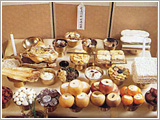 Charye (ancestor memorial services) Charye (ancestor memorial services)On Chuseok morning, family members gather at their homes to hold memorial services (called Charye, 차례) in honor of their ancestors. Formal Charye services are held twice a year: during Seollal (Lunar New Year’s Day) and Chuseok. The difference between the two services is that during Seollal the major representative food is white Tteokguk, a rice cake soup, while during Chuseok the major representative food is freshly harvested rice. After the service, family members sit down together at the table to enjoy delicious food that symbolizes their blessings. |
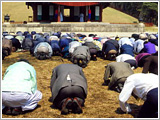 Beolcho (clearing the weeds around the grave) and Seongmyo (visiting ancestral graves) Beolcho (clearing the weeds around the grave) and Seongmyo (visiting ancestral graves)Visiting ancestral graves during Chuseok is known as Seongmyo (성묘). During this visit, family members remove the weeds that have grown around the graves in the summer season, a practice which is called Beolcho (벌초). This custom is considered a duty and expression of devotion and respect for one’s family. On the weekends, about one month prior to the Chuseok holidays, Korea’s highways become extremely congested with families visiting their ancestral graves to fulfill their familial duties. The graves are then visited again during Chuseok. |
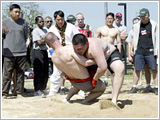 Ssireum (Korean wrestling) Ssireum (Korean wrestling)Traditionally, during the Chuseok holidays the strongest people in each village gather together to hold wrestling competitions. During the match, two competitors face each other in the middle of a circular sandpit surrounded on all sides by cheering spectators. The last wrestler left standing after a series of competitions is considered the winner and is named the village’s strongest man, taking home cotton, rice, or a calf as his prize. Today, Ssireum (씨름, Korean wrestling) competitions are held around the time of Chuseok to determine the strongest man in Korea, but the competitions are not as big a part of the celebrations as they once were. |
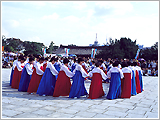 Ganggangsullae (Korean circle dance) Ganggangsullae (Korean circle dance) In this dance, women dressed in Hanbok (traditional Korean clothing) join hands in a circle and sing together. The dance dates back to the Joseon Dynasty (1392-1910) when the Korean army used to dress the young women of the village in military uniforms and had them circle the mountains to make enemy troops think the Korean military was greater in number than it actually was. The Korean army enjoyed many victories thanks in part to this scare tactic. >> Click here to learn more about Ganggangsullae |
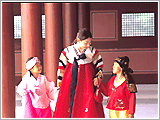 Chuseokbim (Chuseok dress) Chuseokbim (Chuseok dress)During Chuseok, everyone in the household buys and wears new clothes, usually hanbok (Korean traditional clothes). This custom is known as Chuseokbim, and is still practiced today. These days, however, most families purchase clothes from department stores or boutique shops instead of having hanbok made. Dressed in new clothes, families and relatives are ready to celebrating Chuseok. |
 Chuseok Food Chuseok Food |
| Chuseok celebrates the rich harvest season when fruit and grain are abundant. Using the newly harvested grains, people make steamed rice, rice cake, and liquor. |
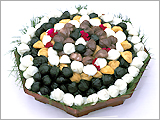 Songpyeon SongpyeonSongpyeon (송편) is one of the representative foods of Chuseok. This rice cake is prepared with rice powder that is kneaded into a size that is a little smaller than a golf ball, and then filled with sesame seed, beans, red beans, chestnuts, or other nutritious ingredients. When steaming the songpyeon, the rice cakes are layered with pine needles to add the delightful fragrance of pine. On the eve of Chuseok, the entire family gathers together to make songpyeon under the bright moon. An old Korean anecdote says that the person who makes beautiful songpyeon will meet a good spouse or give birth to a beautiful baby. It is no wonder that all the single members of a family try their best to make the most beautiful songpyeon! >> Click here to learn how to make Songpyeon |
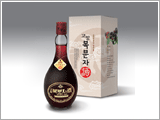 Liquors LiquorsAnother major element of Chuseok is traditional liquor called Baekju (백주, white wine). The holidays are a time of thankfulness and generosity and drinking is a way in which many Koreans show their generosity and affection for their fellow countrymen. >> Go to Traditional Liquors and Wines |









0 comments: